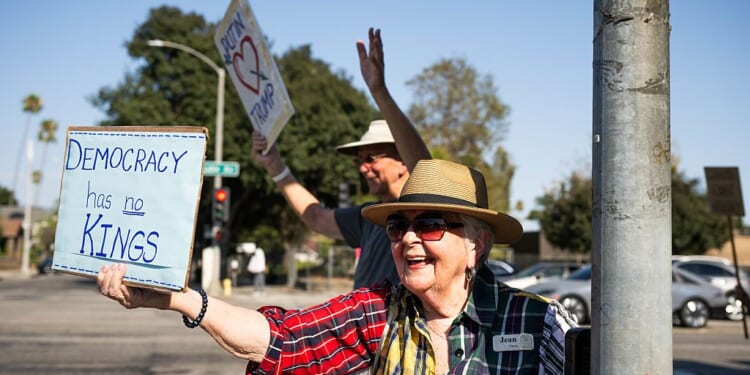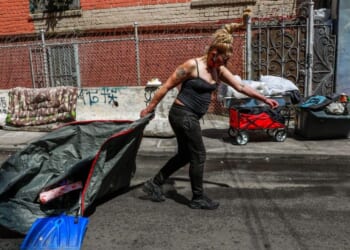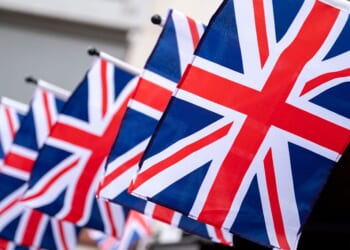When I moved to Moscow in early 1997, Russia was still in the high days of gangster capitalism. The country had been pillaged by a corrupt elite, living standards had collapsed, and Boris Yeltsin, the buffoon president, regularly drank himself into a coma in the Kremlin.
Russians had plenty of reasons to protest, yet very few of them did. This was not because of repression; as flawed and corrupt as he was, Yeltsin was no authoritarian. You were free to mock and deride the head of state, and many did. The issue was that hardly anyone saw the point of protesting as they were too busy struggling to survive. Half a decade into Russia’s experiment with democracy, the state had effectively disintegrated. Thieves and “violent entrepreneurs” rushed in to take advantage of the chaos, and most people accepted there was nothing they could do about it.
Yet one group of Russians refused to accept this national humiliation: the elderly. It was common in those days to see pensioners demonstrating, especially if you worked in central Moscow. I regularly passed by groups of communist babushkas standing in front of the statue of Marshal Zhukov just off Red Square (men were a less common sight; I attributed this to the drastic decline in male life expectancy). In their shawls and overcoats, these old women looked just like the ones you saw lighting candles in churches, except they read Lenin instead of the Bible and held aloft banners featuring the hammer and sickle instead of icons.
At the time, this struck me as a strange and exotic spectacle. My own grandparents, born during the First World War and raised in “Red Clydeside”, the epicentre of radical Scottish leftism, were not political at all. Whether they had been in their youth I did not know. The only activist pensioner I knew of was an old lady from the village of Lumphinnans, who had dictated a memoir of her life as a communist activist; my mother had typed it up for her. We regarded her as “a character”.
In Russia, the radicalism of the old was just as futile, but much more depressing. The Communist Party was led by a mediocrity called Gennady Zyuganov, who had inherited leadership of the proletariat when everybody with talent quit to get rich. In 1996, he ran against Yeltsin for the presidency, who at the time had a 6% approval rating. Zyuganov came within a whisker of winning the first round, but then Yeltsin staged a remarkable comeback, supported by state- and oligarch-controlled media, which blacked out all coverage of the communists. Yet this did not bring out the masses in revolt, only the elderly, and the regime knew it could ignore them. It saw the sea of grey hair and knew that the frail opposition had no place in the future being built.
And so, powerless as they were, the pensioners performed ritual acts. Banners were waved, speeches were given, rallies attended, and holidays celebrated (I remember picking up a flyer for an event commemorating Stalin’s birthday at my local cinema). These protesters had spent their entire lives under communism and endured war and hardship — but they also remembered moments of triumph, like the Red Army raising the Soviet flag over the Reichstag, or Yuri Gagarin beating the Americans in the space race. Now they were being told that their sacrifices were in vain and all that meant nothing. I did not blame them for taking to the streets. To do nothing, to say nothing, would be to admit defeat and acquiesce to their own humiliation.
Around a decade later, I moved to Texas and stopped thinking about elderly protesters. That is, until the second Trump administration got underway. The American variety first came onto my radar when Elon Musk’s DOGE laid siege to USAID, and congressional Democrats, some of whom were considerably older than the Soviet gerontocrats the Western media had once mocked, turned up at the head office to try to gain access. Out of power, these ancient politicians suddenly looked incredibly frail: I couldn’t help but notice their implausible wigs, their halting speech, the tremble in their voices as they attempted to lead a chant that quickly faltered. I saw how easy it was for a security guard to ignore them.
Since then, anti-Trump protests have been held across the nation, and, as many have observed, they are a lot greyer than they were the first time around. At first, I ignored the online snark about “boomer liberals”. But when I reported on a protest against redistricting at the Capitol in Austin in August, it was impossible to ignore the abundance of white hair, the tie-dye t-shirts and occasional wheelchairs. The energy levels were low. Like the wizened Democrats outside the USAID building, the protestors attempted to start up a chant, but it was hesitant and unenergetic and soon died down.
I hadn’t seen so many angry pensioners since Russia. But whereas the babushkas were performing rituals that dated back to the dawn of communism, these elderly Texans were following a script that was written during the heyday of their youth in the Sixties — those heady days of sex, drugs and protests against LBJ and Nixon. Their homemade signs bore profane messages like “GOP Guarding Old Pedophiles”, “Abort Greg Abbott”, and “Fuck ICE, Fuck Trump”.
“I hadn’t seen so many angry pensioners since Russia.”
The aesthetics of it all were very poor. When the rock band Country Joe and the Fish led the crowd in a chant of “FUCK” at Woodstock, it was about youth and sticking it to the man. More than five decades later, the same generation was still in rebellion mode, but the swearing had a crotchety, yelling-at-the-TV energy. When I stumbled upon a No Kings protest in a small town in the Texas Hill Country several weeks later, the atmosphere was more congenial. It ended in time for lunch, and some of the retiree protesters went to get barbecue. It was a nice day out, I suppose, but it wasn’t the future. Like the old communists in Russia, these pensioners had assumed the world they had built would last forever, but now they could feel it receding into history. And just as the regime in Moscow ignored OAP protestors, so Trump was not remotely threatened. He responded by posting an AI video of himself wearing a crown, flying a plane over a crowd and dumping shit on the protesters.
Where have the young people gone? It’s not that Gen Z doesn’t like a good protest: two years of marches against the war in Gaza demonstrated that. Nor is it true that they have lost faith in politics; the recent triumph of Zohran Mamdani in New York demonstrates that they are as easily gulled by charismatic charlatans as every generation that came before them. Perhaps it’s that, rather like the music of Country Joe and the Fish, the story that’s being told just doesn’t resonate in 2025. Trump as tyrant/Hitler/existential threat to democracy etc is a boring, rebooted narrative that didn’t work the first time around, and which doesn’t actually address any of their concerns. And so, as the second Trump administration proceeds, we can expect the median age of the protestors to creep steadily upwards.
On the one hand, I understand the desire to join together and express disapproval, even if it changes nothing — just as those babushkas in Moscow did. There’s something existential about it. But I also wonder whether the best way to spend your final years is in a fit of rage, shaking your fist at a man who will himself very soon exit the stage of history.
For me, the bleakest aspect of today’s geriatric protests is not the ease with which they are ignored, but rather that they reveal the impossibility of escaping from the corrosive effects of American politics. When I see videos of protestors piling unsteadily out of assisted-living facilities, handmade placards in hand, I don’t think “fight the power!” Instead, I imagine retirement homes across the country where the TV is permanently tuned to MSNBC and CNN, and the residents are in a permanent state of febrile rage and terror, fulminating about Trump all day.
Anything — knitting, bridge, chair yoga — would be better than that. I remember a story a friend in Moscow told me about his wife’s 95-year-old grandmother. She had lived through everything from Stalin’s terror to the Second World War to the collapse of the USSR. However, unlike the impoverished babushkas I saw on the street, she lived with her family, was well looked after, and enjoyed good health. She could have rested in those final years, satisfied that she had made it safely to the end, surrounded by her great-grandchildren. Instead, she watched the news obsessively and fretted about the future of Russia.
Given that she was not going to live to see any of the apocalyptic scenarios she was concerned about come to pass, my friend thought that she was upsetting herself needlessly. “Why are you so worried?”, he would ask. But she couldn’t help herself. And so she kept fretting until one day she suffered a fall, dying a week or two later. History rolled on regardless.
There’s a lesson in there, I think. I prefer the way my own grandparents spent their last years — watching game shows on TV, reading books, gardening on their allotment. Dylan Thomas was wrong: given the chance, you absolutely should go gentle into that good night.

















